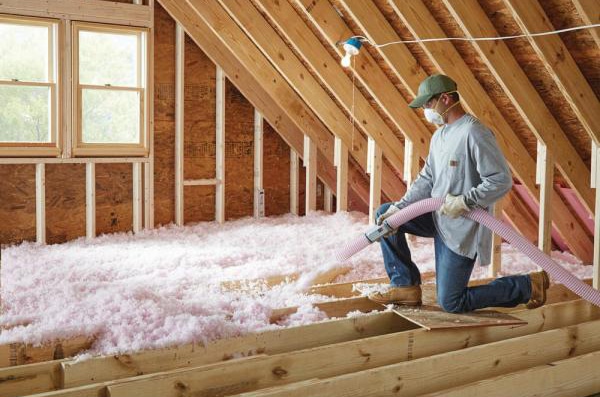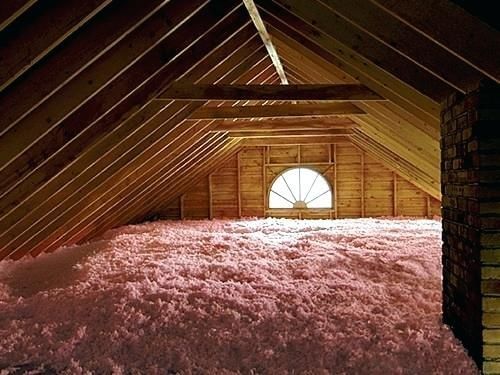Discover the Different Types of Attic Insulation and Their Distinct Advantages for Your Home's Energy Performance

Fiberglass Insulation
Fiberglass insulation is one of one of the most typically utilized products for attic insulation as a result of its exceptional thermal efficiency and cost-effectiveness. Made up of small glass fibers, this product effectively traps air, developing a shielding obstacle that helps maintain constant indoor temperatures. Its high R-value per inch makes it especially efficient at withstanding heat transfer, which is important for power conservation in homes.
Installment of fiberglass insulation is reasonably straightforward, frequently offered in batts or loose-fill kinds, fitting numerous attic configurations. Furthermore, it is immune and non-combustible to wetness, reducing the risk of mold development. This durability adds to its durability, making fiberglass a sensible long-lasting financial investment for homeowners.
In addition, fiberglass insulation is usually made from recycled products, which boosts its eco-friendliness. The material can also add to soundproofing, minimizing sound transfer between spaces. While it is necessary to use protective equipment during installation to prevent irritation from the fibers, the total benefits of fiberglass insulation, including power financial savings and ecological factors to consider, make it a popular option for improving attic performance and advertising a comfy living environment.
Spray Foam Insulation
Spray foam insulation is a very efficient choice for attic room insulation, understood for its remarkable air sealing and thermal efficiency. This innovative insulation material is made up of a blend of isocyanate and polyol material, which, when combined, broadens quickly to fill voids and tooth cavities in the attic room room. Its capability to follow various surfaces guarantees a continual barrier against air leaks, considerably minimizing warm loss during chillier months and warmth gain throughout warmer periods.
Among the key benefits of spray foam insulation is its high R-value per inch, which suggests it gives exceptional thermal resistance in a fairly thin application. This is specifically helpful in attic rooms where room is commonly minimal. Furthermore, spray foam can aid minimize moisture accumulation, decreasing the danger of mold and mildew development, which can be damaging to both the framework and interior air high quality.
While the preliminary expense of spray foam insulation may be higher than conventional choices, its long-lasting power cost savings, combined with enhanced comfort and enhanced home value, make it a beneficial investment for house owners looking for boosted energy efficiency. Attic Insulation DFW. In general, spray foam insulation attracts attention as an effective option for enhancing attic room insulation
Cellulose Insulation

Cellulose insulation is a preferred choice for attic room insulation, mostly composed of recycled paper items treated with fire resistants. This eco-friendly alternative is known for its excellent thermal performance, efficiently decreasing warm transfer in both summer and winter season. The thick composition of cellulose enables it to fill spaces and voids in attic rooms, supplying a smooth barrier versus air leaks.
One of the substantial benefits of cellulose insulation is its capability to resist mold and pests, owing to the fire resistant treatments utilized throughout manufacturing. In addition, it flaunts a high R-value per inch, which equates into remarkable energy performance. House owners can anticipate more information lower cooling and heating costs as a result of enhanced insulation.
Installment is normally completed through blowing loose cellulose right into the wanted area, permitting a fast and reliable procedure. This method likewise decreases disruption to the existing framework. Furthermore, cellulose insulation has a fairly reduced environmental effect, as its manufacturing procedure utilizes recycled products, adding to lasting building methods.
Rock Wool Insulation
Among the different choices for attic insulation, rock wool, likewise understood as mineral wool, sticks out as a result of its remarkable thermal and acoustic efficiency. Made from recycled try this web-site or all-natural materials, rock wool is created by melting rock and spinning it into fibers, leading to an item that supplies exceptional insulation properties.
Among the substantial benefits of rock wool insulation is its high R-value, which indicates its effectiveness in resisting warmth circulation. This particular not only improves energy performance yet likewise contributes to maintaining a comfy indoor temperature year-round. In addition, rock woollen is inherently fire-resistant, making it a more secure choice for homes as it can endure high temperatures without melting or launching hazardous fumes.
Additionally, rock wool insulation succeeds in soundproofing abilities, effectively lowering noise transmission in between spaces and from outside resources. This makes it an optimal choice for home owners looking for a serene living environment. In addition, rock wool is moisture-resistant, aiding to stop mold and mildew growth and keeping the structural honesty of the attic room. Overall, rock woollen insulation provides a detailed option for improving power performance, security, and convenience in property settings.
Radiant Barrier Insulation
Glowing obstacle insulation works as an pop over to this site effective solution for lessening warmth transfer in attic rooms, particularly in warmer climates. This kind of insulation works by showing induction heat far from living rooms, thereby reducing the amount of heat that goes into a home throughout heat - Attic Insulation DFW. Typically composed of a highly reflective material, such as aluminum foil, glowing obstacles are mounted in attic rooms, encountering the roof covering, where they can obstruct inbound warmth from the sunlight
The main advantage of radiant barrier insulation is its capability to lower cooling expenses. By showing warmth rather than absorbing it, radiant barriers can help maintain a more steady indoor temperature, decreasing the workload on air conditioning systems. This efficiency converts right into reduced energy bills and increased convenience for home owners.
Along with power cost savings, radiant obstacles can additionally contribute to improved interior air top quality. By minimizing heat buildup, they aid lessen humidity degrees, which can stop mold development and improve overall air blood circulation. When set up properly, radiant obstacle insulation can be a very useful enhancement to any type of energy-efficient home, making it a worthwhile factor to consider for property owners wanting to boost their attic room insulation strategy.
Verdict
In final thought, understanding the numerous kinds of attic room insulation-- fiberglass, spray foam, cellulose, rock wool, and glowing barriers-- makes it possible for property owners to make enlightened decisions regarding energy performance. Each insulation type offers distinct benefits, such as superior thermal resistance, wetness administration, and sound attenuation. By selecting the ideal insulation material, substantial reductions in energy prices can be achieved, in addition to improvements in indoor convenience. Inevitably, the best selection adds to a much more lasting living environment and promotes general power preservation.

In conclusion, recognizing the different types of attic room insulation-- fiberglass, spray foam, cellulose, rock wool, and glowing barriers-- makes it possible for home owners to make educated choices pertaining to energy efficiency.